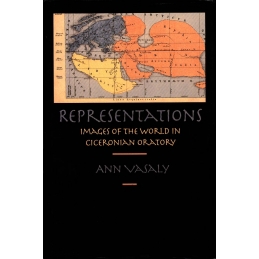
Reference :: DLGM-150508-03
Publisher :: Edizioni Accademia Vivarium novum
Reference :: DLGM-150508-03
Publisher :: Edizioni Accademia Vivarium novum
Reference :: DLGM-060421-01
Publisher :: Librairie Hachette
Reference :: DLGM-150508-01
Publisher :: Edizioni Accademia Vivarium novum
Reference :: DLGM-231009-02
Publisher :: Ophrys


►Vasaly, Ann
En anglais,
University of California Press,
1993, 15,5 x 24, XII + 301 pages, relié, occasion.
9780520077553.
Toilé bleu éditeur avec sa jaquette. Dos imprimé (auteur et titre).
Bon état. Nombreux soulignés au crayon dans le texte.

Security policy

Delivery policy

Return policy
• Ancient rhetorical theory, like some modern criticism of ancient drama (Cf., e.g., E. Fraenkel ad Ag. 613 f),suffered from a divorce of theory and practice whereby the theorists treated their model texts purely as books, without any effort to picture the conditions in which they had functioned on the forensic, political or epideictic 'stage' as a part of a living culture. Moreover, as modern critics have so often taken their cue from their ancient predecessors, certain aspects of ancient oratory have been insufficiently understood and appreciated down to the present day. Now, as is well known, Cicero was extraordinarily sensitive to places and responded particularly to the places where famous men of the past had lived, worked, been buried, etc. What has until the publication of this study by Ann Vasaly (hereinafter V.) been much less remarked is Cicero's very skilful use of place in his speeches -- both the venue of the speech itself and also the places relevant to the particular case or subject. From here V. goes on to the other uses which Cicero makes of place, including playing on Romans' ideas about the world around them and its dangers -- real or imagined. The subject, then, is a promising one.
• The author sets herself the worthy goal of showing that "an understanding of Ciceronian persuasion is a piece of intellectual furniture well worth having" (p.ix). The book accordingly addresses itself not just to specialists but strives to reach a more general audience; hence all the cited Latin is translated by V. herself, and Greek terms are transliterated. V.'s approach to the problem of Cicero's 'relevance' is, of course, merely adumbrated, rather than argued in detail, in the brief preface, which is really a kind of flight-plan for the whole book. V. proceeds to argue that the influence of Ciceronian oratory in the early principate was far from negligible. But her reference at this point to "the mass appeals on which Augustus and his supporters relied" (p.x) is too vague even for a specialist to follow what she means; a cross-reference to pp.13-14 and 241-42, where it becomes clear that she had in mind, not public speeches, but Augustus' res gestae and the map of the world which Marcus Agrippa exhibited on the Campus Martius, would have been welcome. Likewise the appeal "one has only to glance at the pages of Livy to see how thoroughly the speeches were assimilated ..." (ibid.) is too vague to convince the specialist but assumes a specialized knowledge the general reader seems unlikely to possess. Moreover, Cicero's influence or lack thereof in the Augustan Age is in any case unlikely to weigh very heavily with today's general reader. More to the point is the following comparison of Ciceronian oratory with modern democratic rhetoric; when V. speaks of "Cicero's need to sway a large, heterogeneous, and mostly unlettered and uneducated audience", a need which led him to cultivate "rhetorical strategies that depend on integrating words with visual images" (p.xi), we approach closer to the actual terrain to be traversed; one wonders whether, when writing these words, V. thought perhaps of George Bush's 1988 television spot sited at Boston Harbor...
Extrait de Bryn Mawr Classical Review 94.03.15. Reviewed by Andrew R. Dyck, UCLA.
Book information
Reviewed by Andrew R. Dyck, UCLA. : Ann Vasaly, Representations: Images of the World in Ciceronian Oratory. Berkeley: University of California Press, 1993. Pp. xii + 301. ISBN 0-520-07755-5.
Download (0)No customer reviews for the moment.
Reference :: EAG-150420-10
Publisher :: Les Belles Lettres
Reference :: EAG-200322-07
Publisher :: Les Belles Lettres
Reference :: EAL-170823-01
Publisher :: Les Belles Lettres
Reference :: ROM-110414-02
Publisher :: Random House
Reference :: EAG-010620-03
Publisher :: Les Belles Lettres
Reference :: EAG-220521-14
Publisher :: Les Belles Lettres
Reference :: PH-270709-07
Publisher :: Editions Seghers
Reference :: PHA-070521-04
Publisher :: Desclée de Brouwer
Reference :: AGBL-181121-01
Publisher :: Les Belles Lettres
Reference :: HA-120323-01
Publisher :: Fernand Nathan
Reference :: HA-080921-06
Publisher :: Wissenschaftliche Buchgesellschaft - Darmstadt
Reference :: EAL-070323-09
Publisher :: Librairie philosophique J. Vrin

►Vasaly, Ann
En anglais,
University of California Press,
1993, 15,5 x 24, XII + 301 pages, relié, occasion.
9780520077553.
Toilé bleu éditeur avec sa jaquette. Dos imprimé (auteur et titre).
Bon état. Nombreux soulignés au crayon dans le texte.